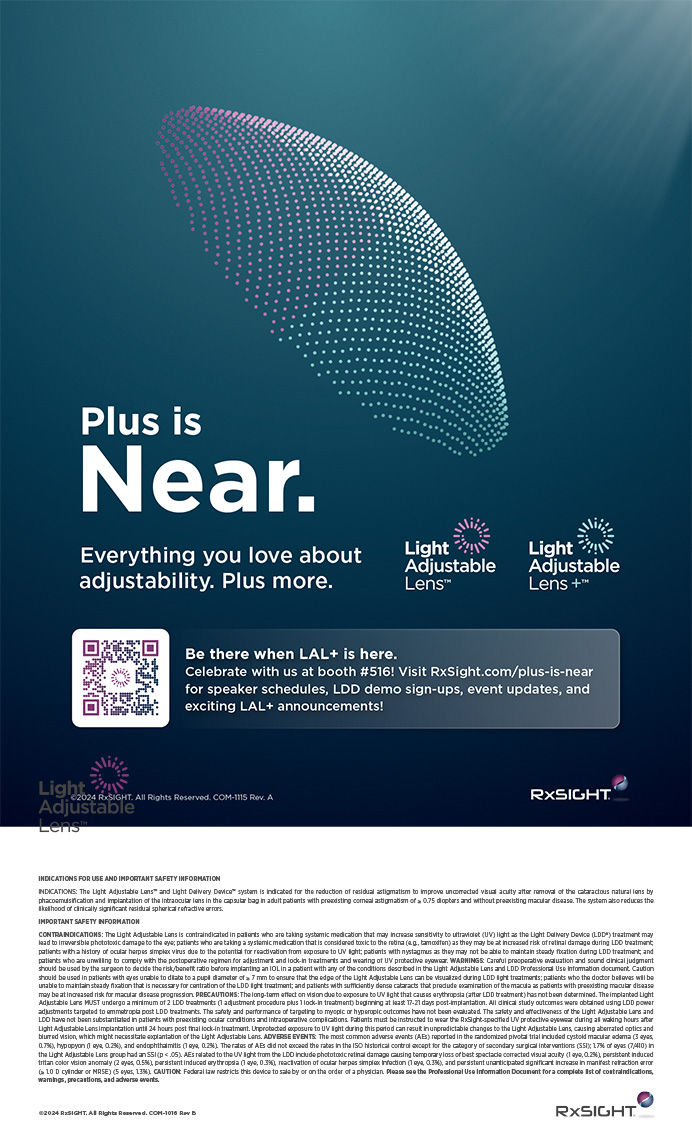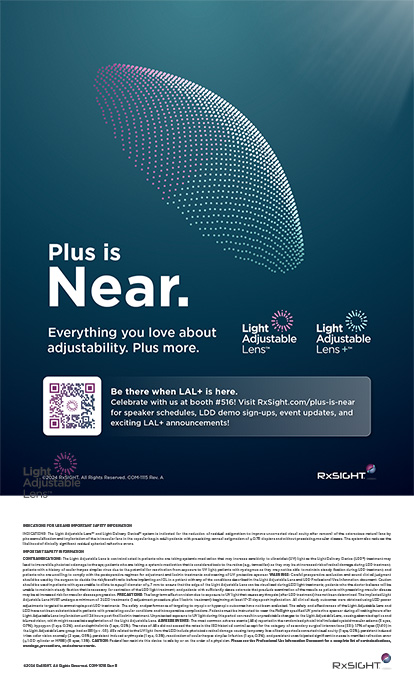In October, the FDA approved Bausch & Lomb's (Rochester, NY) Technolas 217z Zyoptix System for Personalized Vision Correction (Figure 1) for the treatment of up to -7.00 D of spherical myopia and up to -3.00 D of myopic astigmatism. According to Scott M. MacRae, MD, of Rochester, New York, it is the only customized system approved for varying ablation zones, ranging from 6 to 7 mm. Dr. MacRae states that this difference is important because, in the 340-eye FDA study, investigators found that larger ablation zones of 6.5 to 7.0 mm yielded greater improvements in contrast sensitivity under photopic and mesopic conditions as well as in higher-order aberrations than a 6.0-mm ablation zone.
In this article, Dr. MacRae, Stephen G. Slade, MD, FACS, of Houston, and Louis E. Probst, MD, of Ann Arbor, Michigan, describe their experience with the Zyoptix System, share some tips with new users, and make a few predictions for the future of customized LASIK.
DILATION
Bausch & Lomb recommends dilating patients' pupils to at least 6 mm for Zywave measurements. According to Dr. Probst, the theoretical advantage of pupil dilation is that “it allows the measurement of the peripheral aberrations that could contribute to night vision disturbances. Since the goal of custom LASIK is to remove aberrations from the visual system, dilation of the pupil provides a greater assessment of all the aberrations.” Dr. MacRae adds that, because larger pupil diameters prevent the pupillary margin from cutting off or distorting the peripheral lenslets' light spots, the physician achieves a more complete view of each patient's wavefront error.
TOPOGRAPHY
The Zyoptix System's dual workstation combines the Zywave wavefront sensor with the Orbscan topographer, which, Drs. Slade and MacRae note, provides useful data on corneal thickness and curvature as well as height mapping. Dr. MacRae says that topographic information can be useful for screening out unsuitable candidates, but all three physicians emphasize that the wavefront measurement drives the actual treatment.
Dr. Probst states that topographically guided laser ablations have achieved mixed results, so he does not believe that topography is crucial to customized procedures. Nonetheless, Dr. MacRae comments that confirming wavefront data on the magnitude and axis of astigmatism with topographic information can be particularly helpful in highly astigmatic patients.
CLINICAL EXPERIENCETime and Pricing
All three surgeons agree that customized ablation requires more time. Dr. Slade refers to the process as clinically intensive, and Dr. MacRae estimates that patient evaluations for customized procedures last 30 to 60 minutes longer than with conventional LASIK when the surgeon is starting out. He has not found that the actual treatment time is greatly prolonged, however. Performing customized calculations and transferring the data onto a floppy disk takes him approximately
5 to 10 minutes. For Dr. Probst, preoperative assessments and patient counseling require an additional 15 minutes compared with conventional LASIK, and the intraoperative time for performing a bilateral customized procedure requires 4 minutes more. Dr. Slade has reorganized his clinic's resources in order to accommodate the additional time required by patient workups.
Drs. Slade and Probst charge $500 more per eye for customized versus conventional LASIK. Dr. MacRae has increased his fee for customized treatment by between $500 and $800 per eye in order to offset the additional amount of time required and the greater cost of laser cards.
Candidacy
Although Dr. Probst believes that the short-term impact of customized ablation's availability on procedural volume is small (for him, 10%), he believes its long-term effect will be significant. Dr. MacRae adds that the new technology appeals to patients concerned about safety and nighttime vision. Dr. Slade, meanwhile, has successfully used customized ablation to treat patients whose results with previous refractive surgeries were unsatisfactory.
Expectations
Dr. MacRae comments that the FDA study results indicate that customized ablation with the Zyoptix System improves visual clarity and sharpness as well as acuity. Dr. Probst expects to achieve superior results in terms of quality of vision and anticipates a 5% increase in the number of patients who achieve 20/20 acuity. Even so, he notes that results with conventional LASIK are already quite good and considers customized LASIK an evolution rather than a revolution in the procedure.
As Medical Monitor and Chief Investigator for the FDA study of the Zyoptix System, Dr. Slade was immediately impressed by the superior results of customized versus conventional LASIK, even with the earliest surgical nomograms. Nevertheless, he finds that patients' expectations ?are always a step or two ahead of what we are able to deliver,? so patient counseling remains an important part of the process. Similarly, Dr. Probst says that ?the promise of better technology and the higher fee ? have led some patients to demand 20/20 vision.? For that reason, he counsels patients that customized ablation is their best chance for 20/20 UCVA or better, but he emphasizes that the technology does not guarantee them that visual acuity or eliminate their possible need for an enhancement.
TIPS
Dr. MacRae recommends dilating the pupil with 2.5% Neo-Synephrine (Bayer Corporation, West Haven, CT) and 0.25% or 0.50% tropicamide, but he notes that a single drop of Paremyd (1% Neo-Synephrine and 0.25% tropicamide; Akorn, Inc., Buffalo Grove, IL) also works well. Dr. Probst uses one drop of 2.5% Neo-Synephrine combined with a single drop of tropicamide 0.8%. He points out that generously applied Neo-Synephrine can cause toxic keratopathy and distort the wavefront. After the patient's eyes have remained closed for 5 minutes, Dr. Probst ensures that the pupil has dilated to 6.5 mm by means of the Colvard Pupillometer (OASIS Medical, Inc., Glendora, CA).
Additionally, Dr. MacRae suggests printing the pupil and light spot image to ensure symmetric pupil dilation. He has found that the pupillary center may shift 0.1 to 0.3 mm from the dry to wet (pharmacologic) Zywave. Dr. MacRae states that a 0.3-mm (300 µm) decentration results in a 50% reduction in the visual benefit of correcting higher-order aberrations. He administers another drop of 0.5% tropicamide in cases of asymmetric pupils.
Dr. MacRae suggests looking at the point spread function in the undilated Zywave to screen the patient to see if he has significant higher-order aberrations. He says that the Zywave has an illuminance of 0.15 lux, which is close to what he measured with low mesopic nighttime driving on rural roads. Dr. Probst adds that the predicted phoropter refraction should match the manifest measurements by within 0.50 D of the sphere and cylinder and 15º of the axis. Otherwise, he says, the Zyoptix System may not achieve an ideal outcome, so the surgeon should perform conventional LASIK. Dr. Probst also recommends using a nomogram to reduce the spherical component of the correction; for him, it is between 85% and 90%. Lastly, he states that the ideal optical zone is 6.5 mm in most cases.
?Surgeons should avoid frequently changing the zone sizes, as this will affect the predictability of the results,? says Dr. Probst. ?During the procedure, consistent technique is even more important than with conventional LASIK, as the treatments are longer.?
Similarly, Dr. MacRae recommends surgeons use the largest optical zone (6.5 to 7.0 mm) that they can design without compromising the 250-µm LASIK-free zone. He notes that a larger optical zone is possible, because the Zyoptix System's 1-mm spot size and smaller transition zone result in the removal of 20% less tissue.
THE FUTURE
Dr. Slade remarks that wavefront measurements represent a phenomenal leap forward from the traditional process of holding a piece of ground glass before a patient's eye and asking for his subjective evaluation of his vision. According to Dr. Slade, the new technology makes possible a wide range of treatments (eg, multifocal ablations) that may ultimately prove valuable.
Dr. Probst states that iris recognition software and eye tracking speeds of up to 250 Hz will soon be introduced for the Zyoptix System. Within the next few years, he anticipates that engineers will augment the resolution of the Zywave's Hartmann-Shack sensors, thereby helping surgeons treat complex aberrations and complicated cases. In the future, he hopes that pupil dilation may be omitted from preoperative workups without compromising outcomes.
Both Drs. Probst and MacRae acknowledge that biomechanics affect LASIK results.1 Dr. MacRae states that most companies have developed and achieved some success with correction factors that attempt to compensate for biomechanical and epithelial changes. Dr. Probst, however, believes that variable corneal healing will always limit the stability and predictability of LASIK to some extent, as well as the improvements that customized technology can achieve.
According to Dr. MacRae, in addition to the US introduction of the 100-Hz laser source (presently available internationally with the Zyoptix 100 laser system), cyclotorsion correction should become available for the Zyoptix System within the next 6 to 18 months. He adds that further refinements to the platform over the next 5 years will include more sophisticated wavefront sensors that should provide better accuracy and dynamic range, as well as data on the corneal and the lenticular wavefront. Dr. MacRae asserts that the eventual, complete merger of the Zywave aberrometer and Orbscan topographer will enable surgeons to subtract the corneal wavefront map from that of the entire eye, thereby indicating the lenticular wavefront error that the lens creates. He explains that such information could prompt a surgeon to avoid LASIK in a patient whose wavefront error is primarily the result of a cataractous lens. In addition, Dr. MacRae believes that combined wavefront and topographic information will be an asset in cases involving large amounts of higher-order aberrations caused by corneal irregularity.
“One could use the corneal topographic wavefront to drive the initial ablation and reduce most of the wavefront error,” he says. “One could then come back using the entire-eye wavefront and correct more subtle aberrations with that system.”Scott M. MacRae, MD, is Professor of Ophthalmology and Professor of Visual Science at the University of Rochester in New York. He is a consultant to Bausch & Lomb and NIDEK, Inc. Dr. MacRae may be reached at (585) 273-2020; scott_macrae@urmc.rochester.edu.
Louis E. Probst, MD, is Medical Director for TLC Laser Eye Centers in Canada and the US. He is a consultant for Bausch & Lomb. Dr. Probst may be reached at (800) 463-2020.
Stephen G. Slade, MD, FACS, is in private practice in Houston. He is a consultant for Bausch & Lomb. Dr. Slade may be reached at (713) 626-5544; sgs@visiontexas.com.
1. Porter J, MacRae S, Yoon G, et al. Separate effects of the microkeratome incision and laser ablation on the eye's wave aberration. Am J Ophthalmol. 2003;136:327-337.






